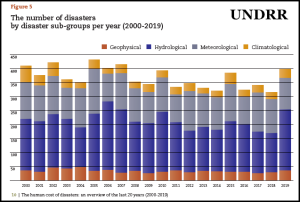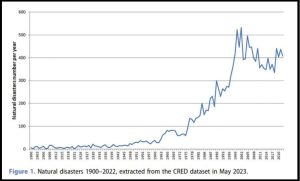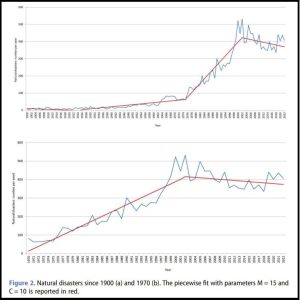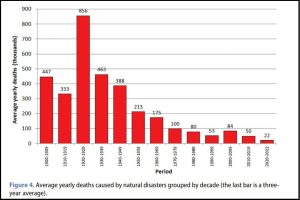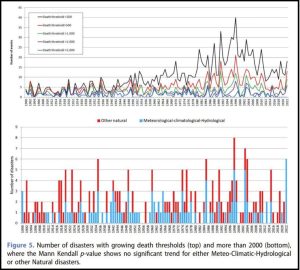Natural Disasters Are Not Increasing — Really
By Kip Hansen
The fact that natural disasters are not increasing and not killing more people – due to climate change or any other fanciful cause — has once more been firmly entered into the peer-reviewed literature in a new paper appearing in the journal Environmental Hazards. The paper is Alimonti and Mariani (2023) titled: Is the number of global natural disasters increasing?
The abstract is available at the link on the title, but for the more-than-curious, the authors have supplied the Accepted Manuscript version and I have made it available in .doc format from the WUWT servers here.
As many know, Roger Pielke Jr. has been treating the world with this news, regarding one type of disaster at a time, through his tweets on X and his substack, The Honest Broker. For example, on U.S. Floods here.
And I have been writing specifically about the international disaster database known as EM-DAT here at WUWT. Starting in 2019 with “How Wrong Can One Article Be”, and followed over the last couple of years with “EM-DAT Disaster Database Creating Data Disasters” and then “EM-DAT: The International Disaster Database”.
Gianluca Alimonti [INFN & Università degli Studi di Milano, Department of Physics, Milano, Italy] and Luigi Mariani [Department of Civil, Environmental, Architectural Engineering and Mathematics (DICATAM), Università degli Studi di Brescia, Brescia, Italy] undertake a serious study of the question of increasing natural disasters because, as they put it:
“The fear of global warming leading to an increase in natural disasters of meteorological origin (drought, extreme rain events, heat waves, landslides, tropical cyclones, tornadoes, etc.) with disruptive effects on human civilization, has recently taken hold. This stimulated the birth of datasets capable of collecting disastrous past events. For example, a dataset exists of the earthquakes that occurred in the distant past in Italy (INGV, n.d.) as well as a dataset of flood events and landslides (CNR, n.d.). International datasets have also been created that aggregate data related to natural disasters. One of these is EM-DAT, which was developed in 1988 by the Center for Research on the Epidemiology of Disasters (CRED [CRED, n.d.]) of the Catholic University of Louvain with the aim of rationalizing decision making to ensure disaster preparedness, while also providing an objective base for vulnerability assessment and priority setting purposes.” — from the abstract of Alimonti & Mariani (2023) (A&M2023 hereafter)
The “fear of global warming” mentioned has been repeatedly caused by various United Nations agencies and departments misrepresenting the EM-DAT data base to the world. The first example, the 2020 report the UN Office for Disaster Risk Reduction (UNDRR) titled “The human cost of disasters: an overview of the last 20 years (2000-2019)”, makes this statement:
‘this report focuses primarily on the staggering rise in climate-related disasters over the last twenty years’.
The UNDRR uses this graphic: …which does not support their statement of increasing disasters, but rather shows disasters either constant or slightly declining. The “staggering rise” is meant to refer to comparing the data for 1980-1999 and 2000-2019.
The actual EM-DAT data looks like this:
Another report from the UN’s Food and Agriculture Organization (FAO) titled “2021 The impact of disasters and crises on agriculture and food security” repeatedly makes the claims like “Disasters steadily on the rise”. FAO is using EM-DAT disaster data shown just above to make the false claim:
“Yet, are disasters truly becoming more frequent and dangerous or are we succumbing to perception bias? Available data shows that increased disaster occurrence is indeed the new normal. While, a quick short-run comparison with the preceding decade shows that there were relatively fewer disaster peak years in the 2010s, the overall level of occurrence remains at an all-time high. With the new millennium, disasters took a drastic leap in frequency and have continued to occur at a consistently high rate over the past 20 years.“
One of the worst exaggerations is from “UN News — Global perspective Human stories” website with the headline:
The headline refers to the report “Atlas of mortality and economic losses from weather, climate and water extremes (1970–2019)” from the UN-associated World Meteorological Organization. The WMO must know it is not true, they’re the world’s weather man.
The Main Stream Media is full of the constant drum-beat claims that disasters are more frequent, more dangerous, more deadly and storms worse.
But….There is a problem. Of which the UNDRR, FAO, WMO and EM-DAT itself, were and are aware:
A&M 2023 does a yeoman’s job of thoroughly investigating the one simple question:
Is the number of global natural disasters increasing?
The paper is a terrific read – it starts by examining the raw EM-DAT data, its data collection history and what claims EM-DAT itself makes for the data, which in its simplest form looks like this:
(numbered Figures 1 – 6 all from A&M 2023)
Without further consideration, this looks like an incredible rise in the number of disasters zooming up to 2000 and then leveling off at “an all-time high”. Alimonti and Muriani (hereafter A&M) use standard statistical techniques, coupled with the history of the dataset, to show that: “Yes, that rise is literally ‘incredible’ – unbelievable.” (My words – kh)
A&M use a standard piecewise regression method to discover break-points in the data set:
And, of course, the same results could have been accomplished using, as I did, my eye-ball method in my earlier essays or with paper-ruler-and-pen work. But, A&M are nothing if not steady and methodical in working through the question being asked, checking and re-checking their own work:
Expand the investigation to a peripheral question, “Are natural disaster causing more human deaths?”, a claim often made in the media as “more deadly”, A&M prepared this graphic:
A&M wryly comment: “Deaths caused by natural disasters since 1900 are shown in Figure 4 as accessory information: the decrease over the years is evident and is certainly not due to disasters decrease, but perhaps to a better prevention and defense capacity.” Over the same time period, 1900 to 2020, human population quadrupled – from 2 billion to over 8 billion – which would have more reasonably skewed the chart in the other direction, quadrupling the deaths in parallel with population growth. [ population data source ]
To round out the investigation, based on the rather low threshold for including a disaster in the EM-DAT database (see Inclusion criteria here), A&M looked at numbers of disasters by increasing the death thresholds:
This view dispels the claims of “more and more deadly.”
I will show one more of the graphics from A&M 2023 that should be used to show that the claim by FAO that climate disasters are increasingly threatening food supplies worldwide:
In the paper, there is a note: “These crops were chosen because they represent the four main world agricultural commodities and account for about 64% of global caloric consumption (Gray et al., 2014).”
A&M conclude:
“The EM-DAT dataset of natural disasters has been analyzed by means of the piece-wise method of Tome and Miranda, and it has been concluded that the trend is not homogeneous over the whole 1900–2022 series due to various factors, the main one being the growing reporting effectiveness. Therefore, before any trend analysis, the time series should be broken into sub-series: the most recent time interval, beginning in the first [22] years of the twenty-first century, shows a decreasing trend whose degree of realism is strengthened by the fact that the time series in the new century can be considered complete, given the increased effectiveness of the monitoring and reporting activities of natural disasters.”
“…the authors are concerned about the misrepresentation of the natural disaster trend because such claims have been uncritically broadcast by many different media and by FAO itself, thereby deforming the perception of the public on the risk of natural disasters.”
“Misinterpreting the trend of natural disasters is a very serious matter because exposes the world population to the risk of inconsistent policies at both a national and an international level, thereby wasting resources or diverting them from the resolution of much more concrete problems.”
This commentary was first published at Watts Up With That on December 1, 2023.
CO2 Coalition Member Kip Hansen is a science research journalist and contributing expert on sea level and sea-level rise. He is a prolific author of numerous articles on the subjects.
# # # # #
Author’s Comment:
I couldn’t agree more. It will take decades to undo the damage caused by the almost-universal misinterpretation of the EM-DAT database by climate change activists and those who are under their thrall in the NGOs, international agencies, governments and, of course, intentionally in the mass media, spurred on by the Climate Crisis news cabals. (and here and here and more).
At the risk of being labeled a pessimist – I am, in my own opinion, a pragmatist — all official bodies will continue to use the false claims made in the various UN-backed reports and parroted in the media. The lie is just far more useful to them than the truth.
The facts about the EM-DAT data have been known for more than a decade – have been publicly acknowledged by EM-DAT, and written about both in the US and Europe – A&M are not the first to do so.
But A&M 2023 is a solid piece of scientific research exposing the widespread misinterpretation and is published in an appropriate peer-reviewed international journal. Hopefully it will make an impact.
As a reminder, an Accepted Manuscript version of A&M 2023 is available for download here.
Thanks for reading.

